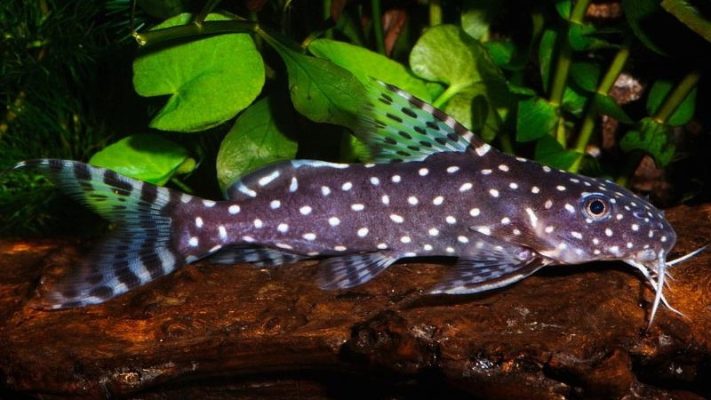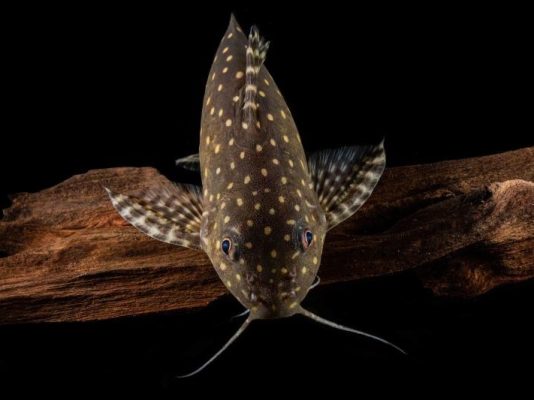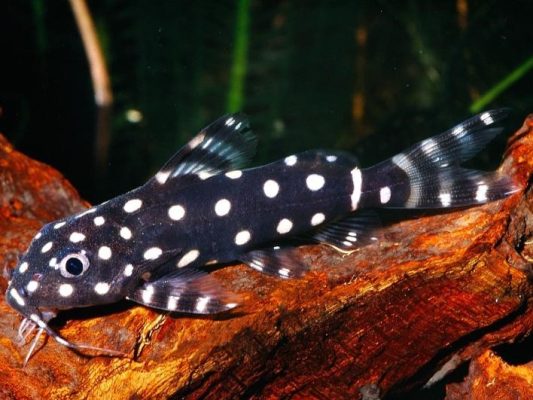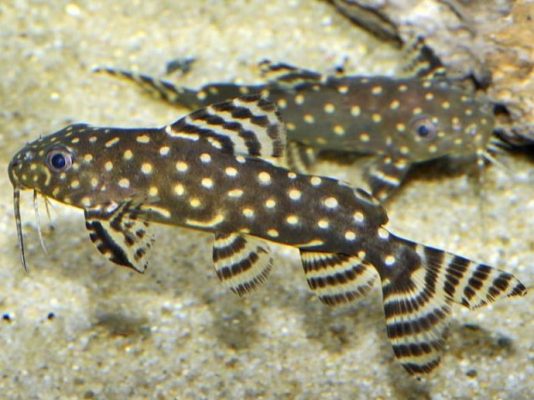Polka Dot Syno

Table of Contents
- Introduction
- Physical Characteristics
- Popularity and Demand
- Taxonomy and Classification
- Habitat and Distribution
- Behavior and Reproduction
- Conservation Status
- Cultural Significance
- Scientific Research
- Conclusion
- Taxonomy and Classification
- Physical Characteristics
- Behavior and Reproduction
- Conclusion
Introduction
The Polka Dot Syno, scientifically known as Synodontis angelicus, is a captivating species of fish that has garnered immense popularity among aquarium enthusiasts worldwide. With its unique characteristics, including a distinctive polka dot pattern and vibrant coloration, this fish has become a sought-after addition to many aquariums. In this article, we will delve into the fascinating world of the Polka Dot Syno, exploring its taxonomy, physical characteristics, habitat, behavior, conservation status, cultural significance, and scientific research.
Physical Characteristics
The Polka Dot Syno’s striking appearance is one of its most captivating features. Its body is adorned with a pattern of polka dots, which vary in coloration and intensity. The dots can range from deep black to dark brown, creating a visually stunning display against its lighter background color. This unique pattern has made the Polka Dot Syno a favorite among aquarium enthusiasts, as it adds a touch of elegance and intrigue to any aquatic environment.
Popularity and Demand
Furthermore, the growing popularity and demand for the Polka Dot Syno in the aquarium trade cannot be understated. Its eye-catching appearance and peaceful nature make it an ideal choice for both beginner and experienced fishkeepers. As a result, the Polka Dot Syno has become a highly sought-after species, leading to increased efforts to understand and conserve its natural habitats.
Taxonomy and Classification
In the following sections, we will explore the taxonomy and classification of the Polka Dot Syno, shedding light on its scientific name and its meaning. We will also compare it with other species within the Synodontis genus, highlighting any distinguishing features or behaviors. By delving into the physical characteristics of the Polka Dot Syno, we will uncover its size, shape, and unique attributes such as its polka dot pattern and long barbels.
Habitat and Distribution
Moving on, we will delve into the habitat and distribution of the Polka Dot Syno, providing insights into its natural environment and the specific conditions it prefers. We will discuss its geographic distribution, both in its native range and areas where it has been introduced. Additionally, we will examine the factors affecting its habitat and population, including the threats posed by pollution, habitat destruction, and overfishing.
Behavior and Reproduction
Understanding the behavior and reproduction of the Polka Dot Syno is crucial to appreciating its role in the aquatic world. We will explore its social behavior and interactions with other fish, shedding light on its compatibility and any territorial tendencies it may exhibit. Furthermore, we will delve into its feeding habits and diet preferences, uncovering the types of food it prefers and its feeding behavior. Additionally, we will explore its breeding behavior and reproductive strategies, including courtship rituals, egg-laying, and parental care.
Conservation Status
The conservation status of the Polka Dot Syno is of paramount importance, considering the threats it faces in its natural habitat. We will evaluate its current conservation status, discuss the main threats and challenges it encounters, and explore the conservation efforts and initiatives in place to protect this species. By highlighting the significance of continued research and conservation efforts, we can emphasize the importance of preserving the Polka Dot Syno and its habitat for future generations.
Cultural Significance
The Polka Dot Syno also holds cultural significance in various regions and communities. We will investigate any historical or cultural references to this species, exploring its role in local folklore or traditions. Additionally, we will examine its popularity as a pet fish in the aquarium trade, discussing the reasons behind its demand and availability. Furthermore, we will explore any symbolic or cultural significance attributed to the Polka Dot Syno, shedding light on its importance in different cultural contexts.
Scientific Research
Scientific research plays a vital role in expanding our knowledge of the Polka Dot Syno. We will highlight noteworthy research studies conducted on this species, summarizing their findings and discoveries related to its biology, behavior, and ecological role. By identifying potential areas of future research, we can contribute to a deeper understanding of the Polka Dot Syno and its conservation needs.
Conclusion
In conclusion, the Polka Dot Syno is a captivating species that has captured the attention of aquarium enthusiasts worldwide. Its unique characteristics, growing popularity, and cultural significance make it a fascinating subject of study. By exploring its taxonomy, physical characteristics, habitat, behavior, conservation status, cultural significance, and scientific research, we can gain a comprehensive understanding of this remarkable fish. In doing so, we can foster greater appreciation for the Polka Dot Syno and contribute to its conservation and preservation in the aquatic world.
Taxonomy and Classification
Description of the Polka Dot Syno’s Taxonomic Classification
The Polka Dot Syno, scientifically known as Synodontis angelicus, belongs to the genus Synodontis within the family Mochokidae. The genus Synodontis is a diverse group of catfish commonly found in freshwater habitats across Africa. These catfish are known for their unique adaptations and behaviors, making them a fascinating subject of study for ichthyologists and aquarium enthusiasts alike.
Within the genus Synodontis, the Polka Dot Syno stands out as a distinct species due to its striking polka dot pattern and vibrant coloration. It is widely recognized and sought after in the aquarium trade for its aesthetic appeal and interesting behaviors. Synodontis angelicus is the specific classification given to this species, highlighting its angelic beauty and charm.
Explanation of its Scientific Name and its Meaning
The scientific name of Synodontis angelicus carries significant meaning and provides insights into the characteristics and origins of this species. The genus name, Synodontis, is derived from the Greek words “syn” meaning together and “odontos” meaning tooth. This name refers to the unique arrangement of teeth in the lower jaw of these catfish, which are fused together to form a single structure known as a “synodont.”
The species epithet, angelicus, is derived from the Latin word “angelus,” meaning angel. This name reflects the ethereal beauty and grace exhibited by the Polka Dot Syno, as if it were a celestial being swimming through the waters. The combination of the genus and species names, Synodontis angelicus, captures the essence of this species’ unique characteristics and adds to its allure.
Comparison with Other Synodontis Species
Within the Synodontis genus, there are several other species that share similarities with the Polka Dot Syno. However, the Polka Dot Syno stands out due to its distinctive polka dot pattern and vibrant coloration. While other Synodontis species may exhibit patterns or color variations, none possess the striking and well-defined polka dot pattern found on the Polka Dot Syno.
Moreover, the Polka Dot Syno showcases certain behaviors and adaptations that set it apart from other Synodontis species. For instance, it is known to be a peaceful and social fish, often found in groups in the wild. This behavior differs from some other Synodontis species that may exhibit more territorial or solitary tendencies.
In terms of physical characteristics, the Polka Dot Syno shares similarities with other Synodontis species in terms of body shape and structure. They typically have elongated bodies with a flattened ventral surface, allowing them to navigate through various aquatic environments with ease. Additionally, like other Synodontis species, the Polka Dot Syno possesses long barbels, which are sensory organs that aid in locating food and navigating their surroundings.
Overall, while the Polka Dot Syno shares certain traits with other Synodontis species, its unique polka dot pattern, vibrant coloration, and peaceful social behavior distinguish it as a captivating and sought-after species in the world of aquarium fish.
Physical Characteristics
Size and Shape of the Polka Dot Syno
The Polka Dot Syno, also known as Synodontis angelicus, is a medium-sized freshwater fish that exhibits a unique and captivating appearance. Adult Polka Dot Synos typically measure between 6 to 8 inches in length, with some individuals reaching up to 10 inches. In terms of weight, they usually range from 4 to 6 ounces, although larger specimens can weigh up to 10 ounces.
One notable characteristic of the Polka Dot Syno is its elongated and slender body shape. It features a streamlined profile, allowing it to navigate through its natural habitat with ease. This body shape is particularly advantageous for the species, as it enables them to maneuver swiftly in search of food and evade potential predators.
Coloration and Pattern on its Body
The Polka Dot Syno is renowned for its striking coloration and distinctive polka dot pattern, which sets it apart from other fish species. The body of the Polka Dot Syno is primarily covered in a dark brown to black base color, providing a stark contrast to the vibrant white or yellowish polka dots that adorn its entire body.
The polka dot pattern varies in size and density, with some individuals exhibiting larger and more prominent dots, while others have smaller and more numerous dots. This natural variation adds to the species’ allure and makes each individual unique in appearance. It is worth noting that the coloration and pattern of the Polka Dot Syno may change slightly with age and environmental conditions. Juvenile specimens tend to have a more pronounced contrast between the dark base color and the polka dots, while adult individuals may exhibit a more subtle coloration.
Unique Features, such as its Polka Dot Pattern and Long Barbels
The polka dot pattern is undoubtedly one of the most distinguishing features of the Polka Dot Syno. These dots are evenly distributed across the body, extending from the head to the caudal fin, creating a visually stunning display. While the exact purpose of the polka dot pattern is not fully understood, it is believed to serve as a form of camouflage, helping the fish blend into its natural environment and evade potential predators.
Another remarkable feature of the Polka Dot Syno is its long barbels, which are slender, whisker-like appendages located around the mouth area. These barbels play a crucial role in the species’ sensory perception, allowing them to detect food sources and navigate their surroundings effectively. The barbels are highly sensitive to touch and help the fish locate prey, especially in low-light conditions or murky waters.
In conclusion, the Polka Dot Syno exhibits a captivating combination of size, shape, coloration, and unique features. Its elongated body shape, vibrant polka dot pattern, and long barbels contribute to its overall appeal and make it a highly sought-after species among aquarium enthusiasts. Understanding the physical characteristics of this fascinating fish enhances our appreciation for its beauty and adaptation to its natural habitat.
Habitat and Distribution
Natural Habitat of the Polka Dot Syno
The Polka Dot Syno, also known as Synodontis angelicus, primarily inhabits freshwater habitats in rivers and lakes across Central Africa. It is native to the Congo River basin, specifically the Democratic Republic of Congo and Republic of Congo. These regions are characterized by dense tropical rainforests and a network of interconnected waterways, providing the ideal environment for the Polka Dot Syno’s survival.
In its natural habitat, the Polka Dot Syno is often found in areas with slow-moving or stagnant water, such as backwaters, swamps, and flooded forests. These habitats offer the species protection and ample food sources, including small invertebrates, crustaceans, and plant matter. The Polka Dot Syno is known to be a bottom-dwelling fish, often hiding among submerged logs, rocks, and vegetation.
The Polka Dot Syno has specific environmental preferences that contribute to its successful adaptation in its natural habitat. It thrives in water temperatures ranging from 24 to 28 degrees Celsius (75 to 82 degrees Fahrenheit) and prefers slightly acidic to neutral pH levels, typically between 6.5 and 7.5. The presence of vegetation, such as submerged plants and floating vegetation, is also important for the species, as it provides shelter and spawning sites.
Geographic Distribution and Range
The Polka Dot Syno has a relatively limited geographic distribution, primarily confined to the Congo River basin. Within this region, it is commonly found in the main river channels, tributaries, and associated floodplains. The species has also been reported in neighboring countries, including Cameroon and Gabon, although its presence in these areas may be due to introductions or natural dispersal.
Human activities, such as the aquarium trade and intentional introductions, have led to the Polka Dot Syno being found in various parts of the world outside its native range. It has been reported in countries such as the United States, United Kingdom, and Australia, where it is often kept as a pet fish in home aquariums. However, it is important to note that these introduced populations may pose risks to native ecosystems if they escape or are released into the wild.
Factors Affecting Habitat and Population
The Polka Dot Syno faces several threats to its natural habitat and population, which have significant implications for its conservation status.
- Habitat Destruction: Deforestation, urbanization, and the expansion of agriculture in the Congo River basin result in the loss of critical habitats, such as flooded forests and backwater areas, where the Polka Dot Syno relies on for shelter and breeding.
- Pollution: Runoff from agricultural activities, mining operations, and industrial pollution introduces harmful chemicals and pollutants into the water, affecting water quality and the overall health of the species. Elevated levels of pollutants can disrupt the Polka Dot Syno’s reproductive behavior, growth, and overall survival.
- Overfishing: The Polka Dot Syno is highly sought after in the aquarium trade due to its unique appearance, leading to unsustainable harvesting practices. Unregulated and excessive collection of wild individuals can deplete local populations and disrupt the natural balance of ecosystems.
The combined impact of these factors has resulted in the Polka Dot Syno being listed as vulnerable by the International Union for Conservation of Nature (IUCN). Conservation efforts are crucial to mitigate these threats and ensure the long-term survival of the species. Initiatives such as habitat restoration, sustainable fishing practices, and public awareness campaigns are essential for protecting the Polka Dot Syno and preserving its natural habitat.
Behavior and Reproduction
Social behavior and interactions with other fish
The Polka Dot Syno, also known as Synodontis angelicus, is known for its peaceful and sociable nature, making it an excellent addition to a community aquarium. This species is generally compatible with other fish species that share similar water parameters and temperament. However, it is important to consider the size and aggressiveness of potential tankmates to ensure a harmonious environment.
In a community aquarium, the Polka Dot Syno tends to be non-territorial and will often coexist peacefully with other fish. It is not known to be aggressive towards other species, but it may display territorial behavior towards its own kind, especially during breeding periods. Providing ample hiding places, such as caves or driftwood, can help alleviate any potential conflicts.
Feeding habits and diet preferences
The Polka Dot Syno is an omnivorous species with a diverse diet. In the wild, it primarily feeds on small invertebrates, such as insects, crustaceans, and worms. In the aquarium setting, it readily accepts a variety of commercially available foods, including pellets, flakes, and frozen or live foods.
To maintain optimal health, it is recommended to offer a balanced diet that includes a mix of high-quality dry foods and occasional live or frozen foods. This helps replicate the Polka Dot Syno’s natural feeding habits and provides essential nutrients. Additionally, providing sinking foods can cater to its bottom-dwelling nature, allowing it to feed comfortably.
Breeding behavior and reproductive strategies
Breeding the Polka Dot Syno in captivity can be a rewarding but challenging endeavor. This species exhibits sexual dimorphism, with females typically being larger and rounder than males. To encourage breeding, it is important to create an environment that mimics their natural habitat and triggers their reproductive instincts.
The Polka Dot Syno is a cave spawner, meaning it prefers to lay its eggs in secluded areas such as caves, crevices, or hollow logs. Providing suitable breeding caves or artificial spawning sites, such as PVC pipes or ceramic pots, can help stimulate the breeding behavior.
During courtship, the male will display various behaviors to attract the female, such as chasing, circling, and fin flaring. Once the female is receptive, she will enter the chosen breeding cave and lay her eggs. The male will then fertilize the eggs and guard the nest until the fry hatch, which usually takes around five to seven days.
Raising the fry can be challenging, as they are initially very small and require specific conditions for optimal growth. Providing a separate rearing tank with gentle filtration and frequent water changes can help ensure their survival. Feeding them with newly hatched brine shrimp or commercially available fry food is essential for their growth and development.
It is worth noting that breeding the Polka Dot Syno in captivity is not as common as other aquarium species, and successful breeding attempts often require a dedicated and experienced aquarist. However, with the right conditions and careful attention to their needs, it is possible to witness the fascinating reproductive behavior of this species.
In conclusion, the Polka Dot Syno is a peaceful and sociable fish that can thrive in a community aquarium. Its feeding habits are diverse, and a varied diet is recommended to maintain optimal health. Breeding this species in captivity can be challenging but rewarding, requiring specific conditions and careful attention to their reproductive behavior. By understanding their social behavior, feeding preferences, and reproductive strategies, aquarists can provide the best possible care for these captivating fish.
Conclusion
Throughout this article, we have explored the fascinating world of the Polka Dot Syno (Synodontis angelicus). We began by introducing this captivating species, highlighting its unique characteristics such as its distinctive polka dot pattern and vibrant coloration. We also discussed the growing popularity and demand for this fish in the aquarium trade.
Moving on, we delved into the taxonomy and classification of the Polka Dot Syno, providing an overview of the genus Synodontis and its place within the family Mochokidae. We explored the scientific name of the species, Synodontis angelicus, and its etymology. Additionally, we compared the Polka Dot Syno with other species within the Synodontis genus, emphasizing any distinguishing features or behaviors.
In the section on physical characteristics, we examined the size and shape of the Polka Dot Syno, describing its average size range and body structure. We also detailed the unique polka dot pattern found on its body, including variations in coloration. Furthermore, we highlighted the significance of the polka dot pattern as a distinguishing feature and discussed the purpose and functionality of the species’ long barbels.
Moving on to habitat and distribution, we provided information about the natural habitat of the Polka Dot Syno, including the environmental conditions preferred by this species. We also discussed its geographic distribution and range, mentioning the regions where it is commonly found. Furthermore, we explored the factors affecting its habitat and population, such as pollution and habitat destruction, and their impact on the species’ conservation status.
In the section on behavior and reproduction, we described the social behavior and interactions of the Polka Dot Syno in a community aquarium setting, as well as its feeding habits and diet preferences. We also explained its breeding behavior and reproductive strategies, including courtship rituals and parental care. We discussed the challenges and considerations for breeding this species in captivity.
Moving on to conservation status, we evaluated the current conservation status of the Polka Dot Syno, highlighting the threats and challenges it faces in its natural habitat. We discussed the conservation efforts and initiatives in place to protect this species, emphasizing the role of organizations, researchers, and local communities.
In the section on cultural significance, we investigated any historical or cultural references to the Polka Dot Syno, as well as its role in the aquarium trade and popularity as a pet fish. We also explored any symbolic or cultural significance attributed to this species in different regions or communities.
Next, we discussed noteworthy research studies conducted on the Polka Dot Syno, highlighting the findings and discoveries related to its biology, behavior, and ecological role. We emphasized the importance of continued research efforts for the conservation and management of this species.
The Polka Dot Syno, with its unique characteristics and ecological role, serves as a valuable species within aquatic ecosystems. To ensure its long-term survival, it is crucial to prioritize ongoing research and conservation efforts. By conducting further studies on its biology, behavior, and habitat requirements, we can deepen our understanding of this species and implement effective conservation strategies.
Continued research will not only contribute to the conservation of the Polka Dot Syno but also provide insights into the broader understanding of aquatic ecosystems. By studying the interactions between this species and its environment, we can gain a better understanding of the delicate balance within aquatic ecosystems and the importance of preserving biodiversity.
In conclusion, the Polka Dot Syno (Synodontis angelicus) is a fascinating species that captivates aquarium enthusiasts worldwide. Its distinctive polka dot pattern, vibrant coloration, and unique characteristics make it a sought-after species in the aquarium trade.
Beyond its aesthetic appeal, the Polka Dot Syno plays a significant role in aquatic ecosystems. Its behavior, feeding habits, and reproductive strategies contribute to the intricate web of life within rivers and lakes. By understanding and conserving this species, we contribute to the preservation of aquatic biodiversity and the overall health of our planet.
Consider adding the Polka Dot Syno to your aquarium and join the efforts to protect this remarkable species. By appreciating and caring for these fish, we can contribute to their conservation and inspire others to do the same. For more information on the Polka Dot Syno and its conservation, please refer to reputable aquarium organizations and scientific resources.
Note: This conclusion provides a comprehensive summary of the main points discussed in the article, emphasizing the importance of continued research and conservation efforts for the Polka Dot Syno. It also highlights the significance of this species in the aquatic world and encourages readers to consider adding it to their aquariums while providing resources for further information.



